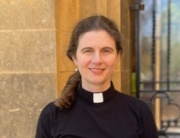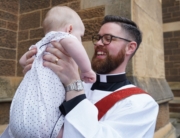
“Were you there?”
The Rev’d Wendy Morecroft
Evensong Sunday 7 April 2019
The Fifth Sunday in Lent
Psalm 130
Isaiah 52.12-53.12
Luke 23.26-49
In the name of God, who is Father, Son and Holy Spirit. Amen.
Our Director of Music, Leonie Hempton, has among many other gifts, a remarkable ability to choose an appropriate anthem for the end of each Evensong service. Tonight’s anthem is an Afro-American (Negro) Spiritual titled “Were you there?” The lyrics of the first verse are “Were you there when they crucified my Lord? Oh, sometimes it causes me to tremble. Were you there when they crucified my Lord?”
We will have an opportunity to immerse ourselves in the crucifixion by attending the services on each day of Holy Week as outlined in our pew sheet.
If we meditate on witnessing the crucifixion, which of the witnesses do we most identify with? We might view the crucifixion from the view of the criminal who derided Jesus saying “Are you not the Messiah? Save yourself and us!” Or we may resonate with the other criminal who rebuked him, saying “Do you not fear God, since you are under the same sentence of condemnation”, but recognising that Jesus is innocent. Would we be the one to ask Jesus to “remember me when you come into your kingdom”? Or would we be the centurion, having witnessed all that had taken place, praising God and saying “Certainly this man was innocent?”
Would we be one of the hoi polloi returning home, beating our breasts? Perhaps we would more likely be one of Jesus’ acquaintances, including the women who had followed him from Galilee, who Luke records as standing at a distance, watching these things?
Theologian Alan Culpepper suggests that those who were with Jesus are not named in tonight’s Gospel because Luke had named them earlier in Chapter 8. The twelve were with him, 2 as well as some women who had been cured of evil spirits and infirmities: Mary, called Magdalene, from whom seven demons had gone out, 3 and Joanna, the wife of Herod’s steward Chuza, and Susanna, and many others, who provided for them[a] out of their resources.
The 2018 film titled “Mary Magdalene” gives us some good food for thought and a vehicle to help us imagine that we were there at the crucifixion. The film does take some licence in interpreting the Gospels. The story was written by Helen Edmundson and Philippa Goslett in honour of Mary of Magdala being recognised by the Vatican in 2016 as the Apostle to the Apostles.
With the insightful direction of Garth Davis, Mary is portrayed as devoted to God, a gifted healer and midwife, at odds with her family because she refuses to marry. She meets Jesus when he is called to heal her of the demons that her family insist, she must have. Mary and Jesus share a love that transcends the physical. The film’s portrayal of Mary Magdalene invites us to observe the events of Jesus’ ministry, passion and death from her perspective; To imagine that we were there when they crucified our Lord.
The film portrays the scene when the Roman soldiers come to seize Jesus right after Judas betrays him. Mary runs towards the soldiers to protect Jesus and is hit on the head and knocked out. When she resumes consciousness, Judas is with her, caring for her.
Mary is desperate to know what has happened to Jesus. Judas tells he that the soldiers took him and he is already being sentenced. She runs frantically through the streets to find him. As she squeezes her way through the crowds, she witnesses Jesus falling to his knees and then onto his face with the heavy wooden beam across his back, nailed and tied around his wrists. He has a crown of thorns on his head and his body is covered in blood. Mary is overcome with shock and horror and stumbles to the gutter where she drops on all fours, possibly dry reaching. She then lays on her back and passes out again.
When she wakes, she sees the carrion eating birds swarming in the sky. She desperately runs to the foot of the cross and kneels, and gazes comfortingly into Jesus’ painfilled eyes. Once he has died, all the women follow as Jesus is carried to his tomb. Mary remains at the tomb, leaning her face against the heavy stone that seals the entrance. She passes out or sleeps again, unwilling to leave.
The second verse of tonight’s anthem reads: “Were you there when the sun refused to shine? Oh, sometimes it causes me to tremble. Were you there when the sun refused to shine?”
We may only imagine what it may have been like to experience being at the crucifixion of Jesus when as tonight’s Gospel says that at about noon, darkness came over the whole land until three in the afternoon.
I was working in Flinders Street in Melbourne on Ash Wednesday, 16 February 1983. On that day over 100 fires were raging across Victoria and South Australia and the city of Melbourne was blanketed in a thick smoke, causing the sky to be blackened and the street lamps to be lit in the middle of the day. There was such a sense of erriness and foreboding, as everyone worried about the devastation and loss of life that was occurring under all that smoke.
Culpepper also writes: “Luke’s statement that the sun’s light “failed” has at times led to the speculation that there was a solar eclipse, but an eclipse would have been impossible at Passover, when there was a full moon….Beyond a possible explanation of the darkness, one has to ask what it might have meant to Luke. In the OT the darkening of the sun was a sign of judgment associated with “the day of the Lord”….The closest parallel to the darkness in the passion narratives [] is Amos 8:9, And on that day,” declares the Lord God, “I will make the sun go down at noon and darken the earth in broad daylight.
It is important for us to understand that this darkness was a supernatural darkness, created by God. The first two lines of Genesis remind us that God has power over the darkness.
Culpepper urges us “not to dispel the darkness of the death of Jesus too quickly.” That “part of the power of the gospel is that it calls us to tarry at the cross and then return home beating our breasts with those whose hopes seemed to have died there. Only by witnessing the darkness of this death and the despair of the loss of hope, can we fully appreciate the joy of the resurrection. God’s purposes for Jesus, the Saviour, however, will not be defeated by the power of darkness. Jesus came “to give light to those who sit in darkness and in the shadow of death.””
This Lent, let us continue our theosis, our journey into God that Dean Frank has been preaching about these past four weeks. Let us sit with the darkness so that we may experience the joy of Christ’s resurrection, imagining that we were there, as the anthem concludes:
“Were you there when he rose up from the grave? Oh, sometimes it causes me to tremble. Were you there when he rose up from the grave?”





